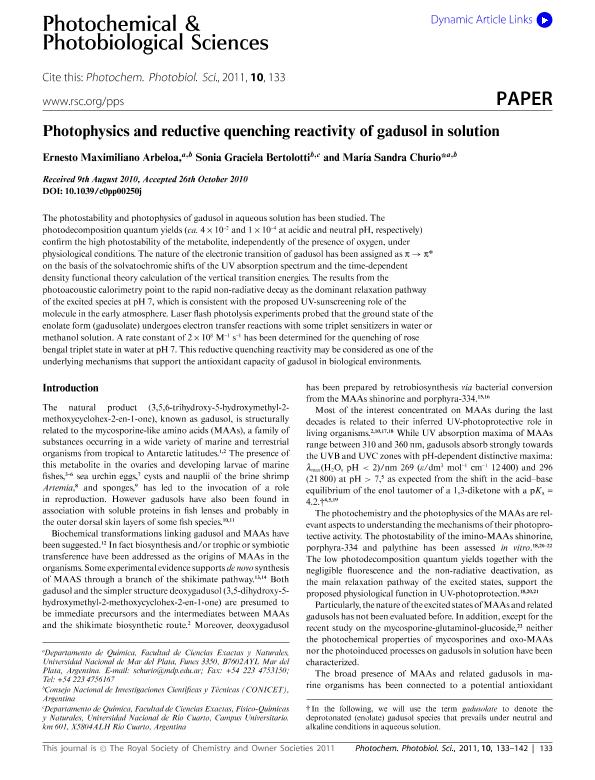Artículo
Photophysics and reductive quenching reactivity of gadusol in solution
Fecha de publicación:
12/11/2010
Editorial:
Royal Society of Chemistry
Revista:
Photochemical and Photobiological Sciences
ISSN:
1474-905X
Idioma:
Inglés
Tipo de recurso:
Artículo publicado
Clasificación temática:
Resumen
The photostability and photophysics of gadusol in aqueous solution has been studied. The photodecomposition quantum yields (ca. 4 × 10-2 and 1 × 10-4 at acidic and neutral pH, respectively) confirm the high photostability of the metabolite, independently of the presence of oxygen, under physiological conditions. The nature of the electronic transition of gadusol has been assigned as π → π* on the basis of the solvatochromic shifts of the UV absorption spectrum and the time-dependent density functional theory calculation of the vertical transition energies. The results from the photoacoustic calorimetry point to the rapid non-radiative decay as the dominant relaxation pathway of the excited species at pH 7, which is consistent with the proposed UV-sunscreening role of the molecule in the early atmosphere. Laser flash photolysis experiments probed that the ground state of the enolate form (gadusolate) undergoes electron transfer reactions with some triplet sensitizers in water or methanol solution. A rate constant of 2 × 108 M-1 s-1 has been determined for the quenching of rose bengal triplet state in water at pH 7. This reductive quenching reactivity may be considered as one of the underlying mechanisms that support the antioxidant capacity of gadusol in biological environments. © The Royal Society of Chemistry and Owner Societies 2011.
Palabras clave:
GADUSOL
,
PHOTOPHYSICS
,
REACTIVE QUENCHING
Archivos asociados
Licencia
Identificadores
Colecciones
Articulos(CCT - CORDOBA)
Articulos de CTRO.CIENTIFICO TECNOL.CONICET - CORDOBA
Articulos de CTRO.CIENTIFICO TECNOL.CONICET - CORDOBA
Citación
Arbeloa, Ernesto Maximiliano; Bertolotti, Sonia Graciela; Churio, Maria Sandra; Photophysics and reductive quenching reactivity of gadusol in solution; Royal Society of Chemistry; Photochemical and Photobiological Sciences; 10; 1; 12-11-2010; 133-142
Compartir
Altmétricas




